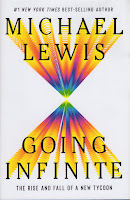Michael Lewis chronicles the rise and collapse of Sam Bankman-Fried who created the cryptocurrency exchange FTX. Without linking them directly to the financial disaster that FTX became, Lewis highlights aspects of Bankman-Fried's character that most likely were the main factors. [364.138092]
Sam Bankman-Fried (often referred to as SBF) led a group of young financial adventurers in an exercise in an exchange for cryptocurrencies that destroyed billions of dollars of other peoples' wealth. He is currently serving a 25-year Federal sentence for conviction of fraud, conspiracy, and money laundering. The author interviewed Mr. Bankman-Fried on several occasions to gather material for the work. The reports of those interviews draw a picture of a socially awkward individual with limited ability to focus fully on the world as it is.
This book provides a detailed biography of Mr. Bankman-Fried and his childhood in the home of two noted Stanford law professors and his own life as a highly talented young mathematician. He undertook his studies at MIT and worked as an intern at the Wall Street trading firm Jane Street Capital. The author then presents a detailed explanation of SBF's commitment to effective altruism, a philosophical school founded on the work of Peter Singer. The tenets of effective altruism are that one should work to maximize the expected benefit of one's charitable actions. This established the logic of SBF to maximize wealth as a way to give more away.
When SBF left Jane Street, his bonus financed his first trades in cryptocurrencies. He worked from the Jane Street methods of high frequency trading to arbitrage price differences in digital currencies in different markets. With financial backing, he formed Alameda Research as a trading vehicle. The success of Alameda Research led SBF to propose a cryptocurrency exchange and hedge fund, FTX. The explosive growth of FTX in a few years gave it a million users at its peak.
The development of more sophisticated traders began to shrink the opportunities for Alameda Research. For SBF, the lines between Alameda, a proprietary trading firm, and FTX, an exchange holding other peoples' money was never very crisp. SBF began lending funds to Alameda from FTX. The rival exchange Binance began to make public noises about FTX's solvency. This generated a run that destroyed FTX because interparty transfers represent fraudulent stewardship of FTX clients' funds are not allowed. Criminal investigation, extradition from the Bahamas, trial, and conviction followed.
The book does not provide much of a ground in understanding cryptocurrencies. The author suggests that he has difficulty in explaining their basis. Given Lewis' personal history, that may say more about the foundations of digital currency than about the author. Where the book is clear is in drawing a picture of Bankman-Fried's personality. It resembles that of a child who is careless and fails to understand what it means to run a business. He is often found to be playing a favorite computer fantasy game even in the middle of conference calls or business discussions. He gives subordinates open funds to undertake projects such as developing a headquarters site with no real guidance or budget. The picture of someone with so much money at his command and so little grounding in reality makes the ending easily predictable. Perhaps that is the book's strength: as a morality play about luck and fantasy and the damage that can result.
Michael Lewis (1960 - ) has authored several books dealing with the behavior of interesting individuals in financial markets, including Liar's Poker and The Big Short.
The book is only marginally recommended as a guide to the financial turmoil and change that cryptocurrencies are wreaking on the markets. It portrays an individual who appears to be incapable of normal human relationships. This quickly read narrative of events provides an analysis only indirectly.









